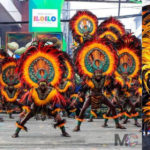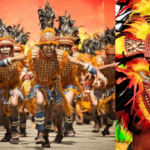In the heart of the Philippines, the vibrant city of Cebu comes alive each January with the resounding beat of drums, colorful costumes, and the rhythmic dance of thousands of devotees and revelers.
In the heart of the Philippines, the vibrant city of Cebu comes alive each January with the resounding beat of drums, colorful costumes, and the rhythmic dance of thousands of devotees and revelers. The Sinulog Festival, a dynamic celebration deeply rooted in religious devotion and cultural pride, stands as one of the most iconic and anticipated events in the country, attracting pilgrims, tourists, and locals alike.
The Sinulog Festival’s origins can be traced back to the early 16th century when Portuguese explorer Ferdinand Magellan gifted an image of the Santo Niño (the Holy Child) to Queen Juana of Cebu. The image, believed to be miraculous, became a symbol of faith and protection. The word “Sinulog” itself is derived from the Cebuano term “sulog,” meaning water current or flow. It reflects the forward-backward dance movements that mimic the current of the river, symbolizing both the indigenous roots and the arrival of the Santo Niño in Cebu.
At the core of the Sinulog Festival is its religious significance. The main event takes place on the third Sunday of January, commemorating the acceptance of Christianity in the Philippines. Devotees, adorned in vibrant costumes, participate in the grand procession, bearing images of the Santo Niño and dancing to the rhythm of drums and traditional instruments. The streets of Cebu become a moving tableau of faith, as the faithful express gratitude and devotion through their energetic and rhythmic dances.
The Sinulog dance itself is a mesmerizing spectacle. Participants, often organized into contingents representing different schools, communities, and tribes, perform intricate dance routines characterized by fluid and graceful movements.
The Sinulog dance itself is a mesmerizing spectacle. Participants, often organized into contingents representing different schools, communities, and tribes, perform intricate dance routines characterized by fluid and graceful movements. The dance is a harmonious blend of indigenous Filipino steps, accompanied by the hypnotic beat of drums and lively music. The Sinulog Festival is a testament to the fusion of pre-colonial traditions with Spanish influences, creating a unique and captivating cultural experience.
A highlight of the festival is the Sinulog Grand Parade, where contingents from various parts of the country compete for the title of champion. Elaborate costumes, inspired by the rich history and folklore of the Philippines, showcase the creativity and artistry of the participants. The streets become a living canvas, depicting scenes from Philippine history, mythology, and religious narratives.
Beyond the religious and cultural aspects, the Sinulog Festival has evolved into a week-long celebration featuring a myriad of events and activities. The Fluvial Procession, a maritime parade, reenacts the arrival of the Santo Niño in Cebu through a boat procession that traverses the Mactan Channel. The Solemn Procession, held on the eve of the grand parade, allows devotees to express their faith through a solemn and prayerful walk.
As one of the largest and most attended festivals in the Philippines, the Sinulog Festival has become a major tourism draw for Cebu.
As one of the largest and most attended festivals in the Philippines, the Sinulog Festival has become a major tourism draw for Cebu. The influx of visitors stimulates the local economy, with businesses flourishing during the festivities. The festival has also become a showcase of Cebu’s cultural heritage, attracting attention not only for its religious significance but also for its role in promoting tourism and fostering a sense of community pride.
In recent years, the Sinulog Festival has expanded its reach through modern media and technology. Livestreams and social media platforms enable people from around the world to witness the grandeur and energy of the festival. This global visibility has further elevated the Sinulog Festival to international acclaim, making it a must-see event for those seeking a vibrant and culturally enriching experience.
In conclusion, the Sinulog Festival is a dynamic tapestry that weaves together the threads of faith, dance, and cultural heritage. It is a celebration that encapsulates the resilience and rich history of the Filipino people. The rhythmic dances, vibrant costumes, and religious fervor create an immersive experience that leaves a lasting impression on both participants and spectators. The Sinulog Festival is not just a celebration; it is a profound expression of Filipino identity, unity, and the enduring spirit of joy that defines the heart of the Philippines.

